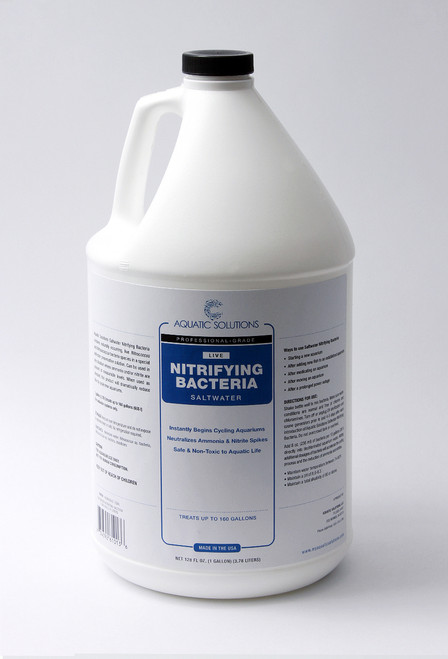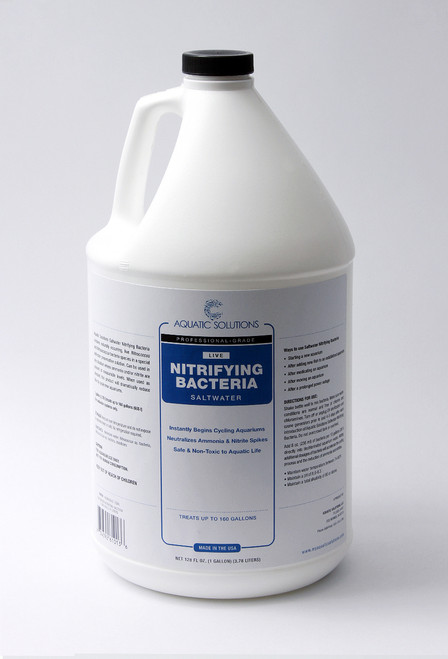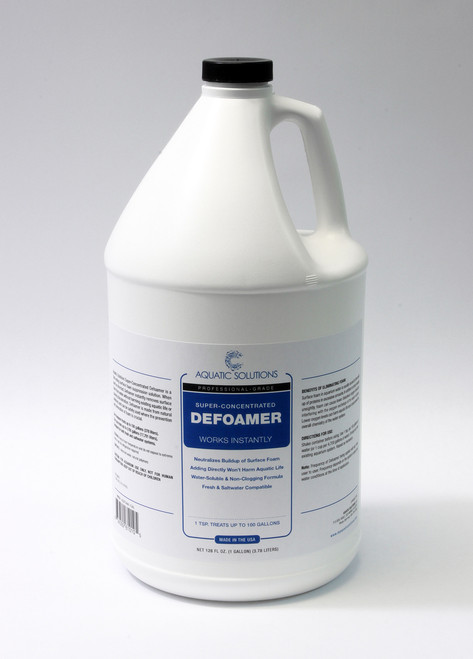Aquatic Solutions, Nitrifying Bacteria(Saltwater) is live bacteria specifically formulated for Aquarium or Aquaculture applications. 1 Gallon Treats up to 160 gallons.
Must be refrigerated at all times and has a shelf life of 3 months.
Ships direct from lab.
Please check with us for availability as lead time may be required.
Ships Monday thru Thursday only! Excludes Holidays
Nitrifying Bacteria Facts
One of the most important, and least understood, aspects of successful aquarium keeping is biological filtration and its function in the nitrogen cycle. Traditionally, novice aquarists become disillusioned at the frequently experienced high death rates of their aquatic pets after setting up a new aquarium. Statistically, as much as 60% of the fish sold for a new aquarium will die within the first 30 days. Two out of every three new aquarists abandon the hobby within the first year.
Known as "New Tank Syndrome" these fish are poisoned by high levels of ammonia (NH3) that is produced by the bacterial mineralization of fish wastes, excess food, and the decomposition of animal and plant tissues. Additional ammonia is excreted directly into the water by the fish themselves. The effects of ammonia poisoning in fish are well documented. These effects include: extensive damage to tissues, especially the gills and kidney; physiological imbalances; impaired growth; decreased resistance to disease, and; death.
Nitrite poisoning inhibits the uptake of oxygen by red blood cells. Known as brown blood disease, or methemoglobinemia, the hemoglobin in red blood cells is converted to methemoglobin. This problem is much more severe in fresh water fish than in marine organisms. The presence of chloride ions (CL-) appears to inhibit the accumulation of nitrite in the blood stream.
The successful aquarist realizes the importance of establishing the nitrogen cycle quickly and with minimal stress on the aquarium’s inhabitants. Aquarium filtration has advanced from the old box filters filled with charcoal and glass wool to undergravel filters, then trickle filters, and most recently - fluidized bed filters. Every advance has been to improve upon the effectiveness of biological filtration which in turn increases the efficiency of the nitrogen cycle. The availability of advanced high-tech filtration systems has lent added importance to the understanding of basic aquatic chemistry.
Nitrifying bacteria are classified as obligate chemolithotrophs. This simply means that they must use inorganic salts as an energy source and generally cannot utilize organic materials. They must oxidize ammonia and nitrites for their energy needs and fix inorganic carbon dioxide (CO2) to fulfill their carbon requirements. They are largely non-motile and must colonize a surface (gravel, sand, synthetic biomedia, etc.) for optimum growth. They secrete a sticky slime matrix which they use to attach themselves.
Species of Nitrosomonas and Nitrobacter are gram negative, mostly rod-shaped, microbes ranging between 0.6-4.0 microns in length. They are obligate aerobes and cannot multiply or convert ammonia or nitrites in the absence of oxygen.
Nitrifying bacteria have long generation times due to the low energy yield from their oxidation reactions. Since little energy is produced from these reactions they have evolved to become extremely efficient at converting ammonia and nitrite. Scientific studies have shown that Nitrosomonas bacterium are so efficient that a single cell can convert ammonia at a rate that would require up to one million heterotrophs to accomplish. Most of their energy production (80%) is devoted to fixing CO2 via the Calvin cycle and little energy remains for growth and reproduction. As a consequence, they have a very slow reproductive rate.







